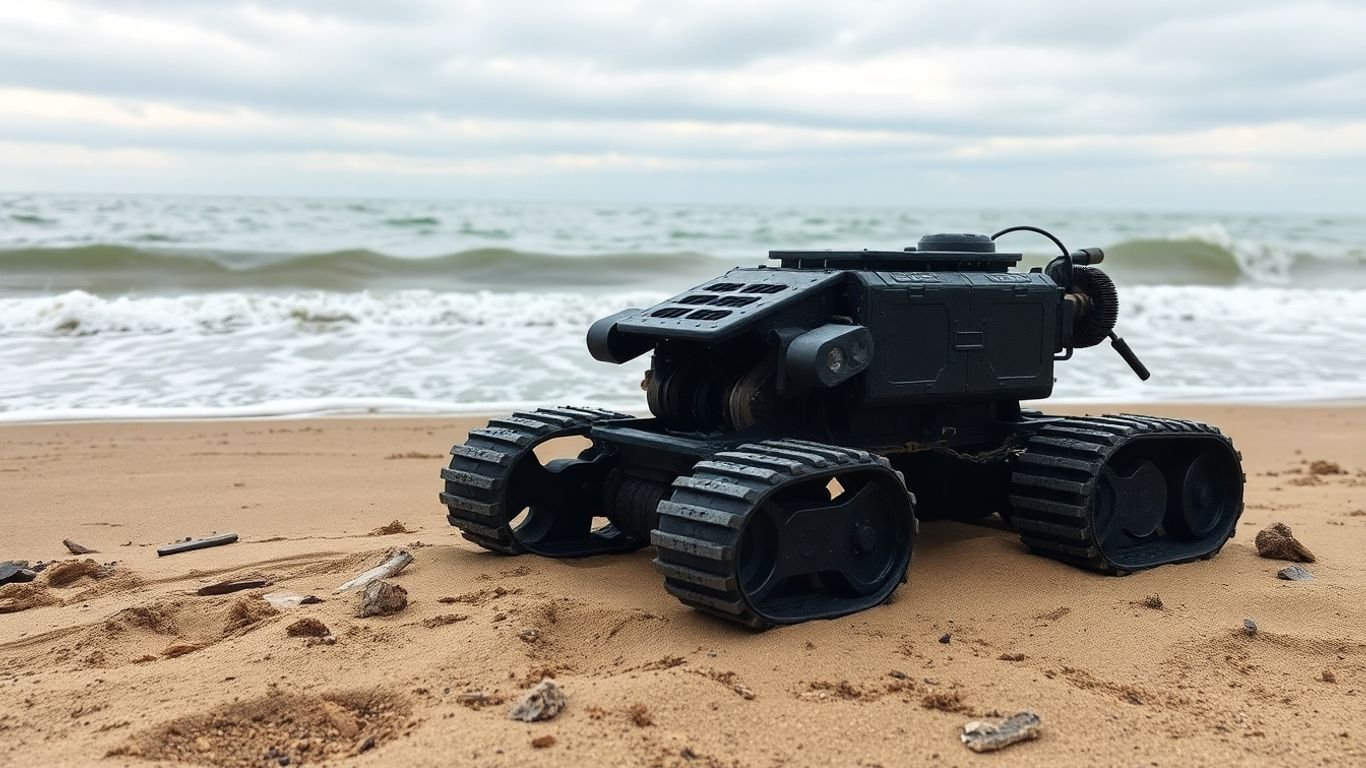Canadian Ground Robot Survives Atlantic Drop, Navigates to Shore

So, get this: a Canadian ground robot, the Mission Master 2.0, actually took a dive into the Atlantic Ocean. Yep, you read that right. It was dropped off a warship and then, on its own, it chugged its way to a beach in Portugal. This whole thing was part of a big NATO exercise to check out how these unmanned machines work for sea stuff. Pretty wild to think a robot can just handle that kind of trip without anyone piloting it.
Key Takeaways
- A Canadian ground robot, the Mission Master 2.0, was tested by being dropped into the Atlantic Ocean and successfully driving itself to shore.
- This test happened during a NATO exercise focused on evaluating unmanned systems for operations involving both sea and land.
- The robot was equipped with special gear, like a drone and advanced sensors, to help it scout and gather information.
- The Mission Master 2.0 has been updated based on feedback from users in places like the U.S. and the UK, making it tougher and more stable, especially in saltwater.
- This event shows a growing trend where military forces are looking to use robots that can work across different environments, from the sea to the land.
Canadian Ground Robot’s Atlantic Voyage

So, get this – a Canadian ground robot, the Mission Master 2.0, actually took a dive into the Atlantic Ocean. Not like, a planned dive, but it was dropped off a warship as part of a big NATO exercise. The whole point was to see if this amphibious UGV could make it back to shore all by itself. And guess what? It did. It successfully completed a sea-to-shore transit and landed on a Portuguese beach. This whole unmanned ground vehicle maritime test is pretty wild when you think about it.
Amphibious Mission Master Tested in NATO Exercise
This whole event went down during NATO’s Robotic Experimentation and Prototyping using Unmanned Systems exercise. It was a massive gathering, with 24 countries showing up and over 276 different unmanned systems being checked out for maritime jobs. The Mission Master 2.0 was loaded onto a warship that sailed into some rough waters. Then, using a crane, it was lowered into the sea. Its mission? To find its way back to the beach near where the testing was happening. This unmanned ground vehicle maritime test showed it could handle the journey without any humans having to tow it or pull it out of the water.
Sea-to-Shore Transit Achieved Without Human Intervention
What’s really neat is that the robot sea-to-shore navigation part was completely autonomous. It didn’t need a person guiding it or helping it out once it hit the water. This is a big deal because it means these kinds of robots can be used in situations where sending people might be too risky. The vehicle was kitted out with some serious tech for this trip, including a tethered drone, radar, and sensors from Rheinmetall Canada robotics.
Successful Navigation to Portuguese Beach
After its dip in the Atlantic, the Mission Master 2.0 didn’t just float around. It actively drove itself to the beach. This part of the test focused on how well the robot could handle the transition from water to land, especially on uneven shoreline terrain. The folks at Rheinmetall mentioned that this version of the robot had been upgraded based on feedback from users in places like the U.S., Norway, and the UK. They were specifically looking to make it more stable and reliable when dealing with saltwater conditions and tricky beach areas. It’s pretty impressive to think about an autonomous robot in saltwater conditions making its way to land.
The successful Atlantic drop test of the Canadian ground robot highlights a significant step forward in military robotics. Its ability to transition from sea to shore autonomously opens up new possibilities for reconnaissance and support operations in coastal environments.
Advanced Capabilities of the Mission Master 2.0
The Mission Master 2.0 isn’t just any robot; it’s built with some serious upgrades, especially for tough jobs like the one it just did in the Atlantic. This version has been tweaked based on what soldiers and sailors from places like the U.S., Norway, and the UK have said they need. They focused on making it tougher and more stable, which is pretty important when you’re dealing with salty water and bumpy beaches.
Modular Kit for Maritime Operations
For this Atlantic trip, the Mission Master 2.0 was kitted out for sea-to-shore action. It had a special package that included:
- A tethered drone from Elistair (France) for a bird’s-eye view.
- An Echodyne radar from the U.S. to see what’s around.
- Rheinmetall’s own mast and sensor setup for more eyes and ears.
This whole setup is designed to help with scouting, sensing, and keeping communications open, which is exactly what navies and marine forces are looking for in their unmanned gear these days.
Integrated Sensors and Tethered Drone
Think of the Mission Master 2.0 as having a whole suite of sensors. The integrated radar helps it understand its surroundings, even in tricky weather. And that tethered drone? It’s like having a mobile lookout post that can hover and give a constant feed of information, extending the robot’s senses way beyond its own body. This combination means it can spot things from further away and get a clearer picture of the area it’s operating in.
Enhanced Scouting and Communications Support
Beyond just moving around, the Mission Master 2.0 is a communication hub and a scout. It can relay messages and provide real-time data from its sensors and the drone. This means ground forces can get information faster and stay connected, even when they’re pushing into new or dangerous territory. It’s all about giving the human operators better information so they can make smarter decisions.
The focus on making the Mission Master 2.0 more stable in saltwater and on uneven shorelines shows a practical approach to real-world military needs. It’s not just about having advanced tech, but making sure that tech actually works when and where it’s needed most.
Operator-Driven Enhancements for Robustness
The Mission Master isn’t just a static piece of tech; it’s a system that’s constantly getting better, thanks to the folks actually using it. Feedback from international partners has been a big deal in shaping what this robot can do, especially when it comes to handling tough conditions. They’ve really focused on making it more stable when it’s in saltwater and improving how it moves around on the beach once it gets there.
Upgrades Based on International Feedback
Think of it like this: soldiers and sailors are out there, putting the Mission Master through its paces in real-world scenarios. They’re seeing what works and what doesn’t, and then they’re telling the engineers. This back-and-forth has led to some smart tweaks. For instance, the control systems have been refined to be more intuitive, and the overall user interface is easier to manage, even when things get hectic.
Increased Stability in Saltwater Conditions
Getting a ground robot to float and move in the ocean is one thing, but keeping it steady is another. The engineers have worked on the hull design and the buoyancy systems. They’ve also adjusted the propulsion to handle waves and currents better. It’s not about making it a speedboat, but about making sure it can get from point A to point B without tipping over or getting swamped.
Improved Performance on Shoreline Terrain
Once the Mission Master hits the sand, it needs to keep going. The tracks and suspension have been upgraded to handle different types of ground, from soft sand to rocky areas. This means it can get onto the beach and move inland more effectively, carrying whatever it needs to carry or scouting ahead without getting stuck. It’s all about making sure it’s useful the moment it leaves the water.
The Mission Master Family and Autonomy
Rheinmetall’s Mission Master line isn’t just one robot; it’s a whole family of unmanned ground vehicles (UGVs) built for all sorts of jobs. Think about it – these machines can be used for keeping watch, hauling supplies, helping out with injured soldiers, acting as communication hubs, or even supporting troops with firepower. They’ve really thought about making these robots useful in many different situations.
Versatile UGVs for Diverse Mission Sets
The cool thing about the Mission Master is how adaptable it is. You’ve got different sizes and configurations, so you can pick the right one for what you need to do. Whether it’s scouting ahead in tricky spots, moving gear from a ship to the shore, or providing a steady communications link, there’s a Mission Master model that can handle it. It’s like having a toolbox full of robotic helpers ready for action.
Rheinmetall’s Path Autonomous Kit
What makes all these Mission Masters tick is Rheinmetall’s Path autonomous kit, or ‘A-kit’ as they call it. This is the brains behind the operation, letting the robots do things like follow a lead vehicle, move in a convoy, or even go completely solo. This technology is designed to take some of the repetitive tasks off soldiers’ plates, letting them focus on more important things. The A-kit is built with an open design, which means it can easily take on new tech as AI gets better. So, you can swap out sensors or update software without needing a whole new robot, which is pretty smart.
Human-in-the-Loop for Kinetic Operations
Now, even with all this advanced tech, Rheinmetall is clear about one thing: they want a human involved when it comes to using weapons. The idea is that a machine shouldn’t be the one deciding to fire. It’s about keeping that human judgment in the loop, especially as AI gets more capable. This approach makes sure that the robots are tools to support soldiers, not replacements for their decision-making in critical moments.
Here’s a quick look at some of the roles Mission Master vehicles can fill:
- Surveillance and Reconnaissance
- Logistics and Supply Transport
- Casualty Evacuation Support
- Communications Relay
- Fire Support Coordination
The flexibility of the Mission Master platform, combined with its advanced autonomous capabilities, means it can be adapted for a wide range of military needs. This adaptability is key for modern forces looking to integrate robotic systems effectively into their operations, from the sea to the land.
Broader Trends in Unmanned Systems
It’s pretty wild how quickly robots are showing up in places we used to only see people. This whole Mission Master thing, going from the sea to the beach? That’s part of a bigger picture. Militaries are really starting to think about how to use robots that can handle both water and land. Think about it: a robot scouting out a beach before troops land, or carrying supplies across tricky shoreline terrain. It’s all about making those complex amphibious operations a bit less risky and a lot more efficient.
Bridging Sea and Land Operations
This isn’t just a one-off experiment. We’re seeing a real push to get unmanned systems to work across different environments. The idea is to have robots that can do things like:
- Scout ahead in unfamiliar territory.
- Gather intel on coastal areas.
- Transport gear from ships to shore.
- Act as communication relays.
The ability for these machines to operate in both aquatic and terrestrial settings is a game-changer for military planning. It opens up new ways to approach missions that were previously very difficult or dangerous for human soldiers. It’s about extending our reach and capabilities without putting people directly in harm’s way from the start. This kind of tech is becoming a big part of emergency response frameworks.
Intelligence Gathering in Littoral Zones
Littoral zones – that’s the area where the land meets the sea – are always tricky. They’re often the first point of contact in an invasion or a defense. Having robots that can quietly move through these areas, gather information, and send it back is incredibly useful. They can check out potential landing spots, identify threats, and give commanders a much clearer picture before any major moves are made. This kind of persistent surveillance can make a huge difference in how a mission unfolds.
Partnerships Between Robotic Systems
What’s also interesting is how these different robots are starting to work together. It’s not just about one robot doing its job anymore. We’re seeing concepts where ground robots, aerial drones, and even naval systems coordinate. For instance, a ground robot might identify a target, then relay that information to a drone or a loitering munition for a quick strike. This kind of networked approach means that each system can do what it does best, creating a more effective overall team. It’s like building a digital squad where each member has a specific role, and they all communicate to achieve a common goal.
Integration with Partnered Systems

Showcasing Rapid-Response Capabilities
This recent exercise really hammered home how different robotic systems can work together. It wasn’t just about the Mission Master making it to shore; it was about what it could do once it got there, especially when teamed up with other gear. Think of it like a well-coordinated sports team, where each player has a specific role but they all work towards the same goal. The Mission Master, after its splashy arrival, can act as a mobile command post or a scout, feeding information back to other units. This ability to link up with other specialized systems is a big deal for modern military operations. It means faster reactions and more flexible mission planning.
Loitering Munitions and Targeting Chains
One of the coolest parts of the demonstration involved a loitering munition, the Hero-120 from Uvision. They showed how quickly a target could be identified and engaged. Imagine the Mission Master spotting something on the beach, relaying that info, and then the loitering munition being launched to take care of it. Reports from the event mentioned a scenario where, after getting mission details and target coordinates, the system was ready to launch and strike within just two minutes. That’s seriously fast.
Here’s a quick look at how that might play out:
- Reconnaissance: Mission Master identifies a threat.
- Data Relay: Information is sent to a command unit.
- Targeting: Command unit designates the target.
- Engagement: Loitering munition is launched and strikes.
- Confirmation: Mission Master or another unit confirms the strike.
Synergy in Near-Shore Operations
What all this points to is a future where land and sea robots aren’t just operating in isolation. They’re part of a bigger network. The Mission Master’s trip across the Atlantic and its successful beach landing is just the first step. The real power comes when it can connect with aerial drones, other ground vehicles, and even naval assets. This kind of teamwork allows for better intelligence gathering in tricky coastal areas and quicker responses to developing situations. It’s all about making sure the right tools are in the right place at the right time, and that they can talk to each other effectively. This is a key part of how militaries are looking to use unmanned systems in the future.
The integration of various robotic platforms, from amphibious ground vehicles to aerial drones and loitering munitions, is reshaping how military forces approach complex environments like coastlines. This interconnectedness allows for a more dynamic and responsive operational capability, moving beyond single-system performance to networked effectiveness.
What’s Next for These Robots?
So, this whole thing with the Canadian robot getting tossed into the ocean and then just driving itself to shore? Pretty wild, right? It really shows how far this robot stuff has come. They’re not just for science fiction anymore. This test, part of a big NATO exercise, proved that these machines can handle tough jobs, like going from a ship to land without anyone needing to hold their hand. With all the upgrades they’re putting into these things, making them tougher and more stable, especially in salty water, it looks like we’ll be seeing a lot more of them. They’re getting smarter too, with kits that can be swapped out easily. It’s kind of a big deal for how armies might operate in the future, especially when they need to get things done on beaches or tricky coastlines. We’ll have to wait and see what else these robots can do.
Frequently Asked Questions
What happened in the Canadian robot test?
A Canadian robot called the Mission Master 2.0 was dropped from a big ship into the Atlantic Ocean. It then drove itself all the way to a beach in Portugal without any people helping it. This showed it could go from the sea to the land on its own.
What is the Mission Master 2.0?
The Mission Master 2.0 is a tough robot vehicle that can travel on land and in water. It’s designed to help soldiers with different jobs, like scouting, carrying things, or acting as a communication hub. It can also carry special tools like drones and radar.
Was the robot controlled by a person?
While the robot can be controlled by people, in this test, it drove itself to the shore. It has smart technology that allows it to navigate and make decisions, but for important actions like firing weapons, a person is always in charge.
Why was this test important for NATO?
This test was part of a big NATO exercise where many countries tested different kinds of robots for military use, especially for jobs involving both the sea and land. It showed how robots can help soldiers in tricky situations like landing on a beach from a ship.
What kind of special equipment did the robot have?
The robot was loaded with a special package for its trip. This included a drone that stays connected by a cord, a radar system to see things, and other sensors made by the company Rheinmetall to help it understand its surroundings and communicate.
Are there other robots like the Mission Master?
Yes, the Mission Master is part of a family of robots made by Rheinmetall. These robots come in different sizes and can be used for many different tasks, like watching areas, moving supplies, or helping injured soldiers.






